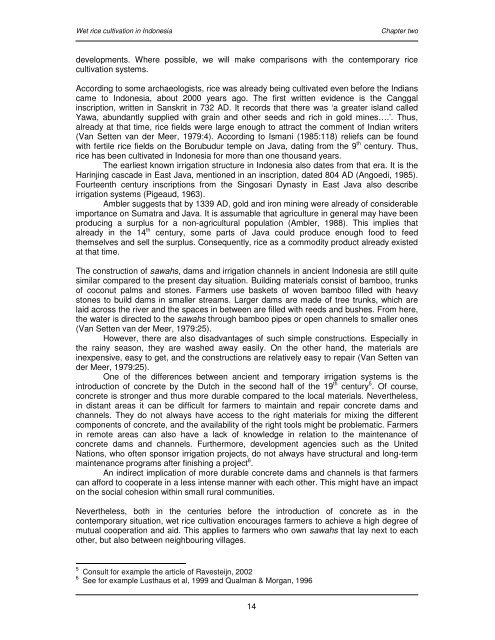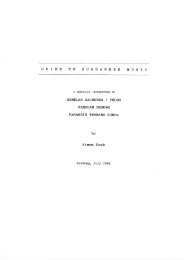Wet rice cultivation in Indonesia - Free EBooks Library
Wet rice cultivation in Indonesia - Free EBooks Library
Wet rice cultivation in Indonesia - Free EBooks Library
Create successful ePaper yourself
Turn your PDF publications into a flip-book with our unique Google optimized e-Paper software.
<strong>Wet</strong> <strong>rice</strong> <strong>cultivation</strong> <strong>in</strong> <strong>Indonesia</strong> Chapter two<br />
developments. Where possible, we will make comparisons with the contemporary <strong>rice</strong><br />
<strong>cultivation</strong> systems.<br />
Accord<strong>in</strong>g to some archaeologists, <strong>rice</strong> was already be<strong>in</strong>g cultivated even before the Indians<br />
came to <strong>Indonesia</strong>, about 2000 years ago. The first written evidence is the Canggal<br />
<strong>in</strong>scription, written <strong>in</strong> Sanskrit <strong>in</strong> 732 AD. It records that there was ‘a greater island called<br />
Yawa, abundantly supplied with gra<strong>in</strong> and other seeds and rich <strong>in</strong> gold m<strong>in</strong>es….’. Thus,<br />
already at that time, <strong>rice</strong> fields were large enough to attract the comment of Indian writers<br />
(Van Setten van der Meer, 1979:4). Accord<strong>in</strong>g to Ismani (1985:118) reliefs can be found<br />
with fertile <strong>rice</strong> fields on the Borubudur temple on Java, dat<strong>in</strong>g from the 9 th century. Thus,<br />
<strong>rice</strong> has been cultivated <strong>in</strong> <strong>Indonesia</strong> for more than one thousand years.<br />
The earliest known irrigation structure <strong>in</strong> <strong>Indonesia</strong> also dates from that era. It is the<br />
Har<strong>in</strong>j<strong>in</strong>g cascade <strong>in</strong> East Java, mentioned <strong>in</strong> an <strong>in</strong>scription, dated 804 AD (Angoedi, 1985).<br />
Fourteenth century <strong>in</strong>scriptions from the S<strong>in</strong>gosari Dynasty <strong>in</strong> East Java also describe<br />
irrigation systems (Pigeaud, 1963).<br />
Ambler suggests that by 1339 AD, gold and iron m<strong>in</strong><strong>in</strong>g were already of considerable<br />
importance on Sumatra and Java. It is assumable that agriculture <strong>in</strong> general may have been<br />
produc<strong>in</strong>g a surplus for a non-agricultural population (Ambler, 1988). This implies that<br />
already <strong>in</strong> the 14 th century, some parts of Java could produce enough food to feed<br />
themselves and sell the surplus. Consequently, <strong>rice</strong> as a commodity product already existed<br />
at that time.<br />
The construction of sawahs, dams and irrigation channels <strong>in</strong> ancient <strong>Indonesia</strong> are still quite<br />
similar compared to the present day situation. Build<strong>in</strong>g materials consist of bamboo, trunks<br />
of coconut palms and stones. Farmers use baskets of woven bamboo filled with heavy<br />
stones to build dams <strong>in</strong> smaller streams. Larger dams are made of tree trunks, which are<br />
laid across the river and the spaces <strong>in</strong> between are filled with reeds and bushes. From here,<br />
the water is directed to the sawahs through bamboo pipes or open channels to smaller ones<br />
(Van Setten van der Meer, 1979:25).<br />
However, there are also disadvantages of such simple constructions. Especially <strong>in</strong><br />
the ra<strong>in</strong>y season, they are washed away easily. On the other hand, the materials are<br />
<strong>in</strong>expensive, easy to get, and the constructions are relatively easy to repair (Van Setten van<br />
der Meer, 1979:25).<br />
One of the differences between ancient and temporary irrigation systems is the<br />
<strong>in</strong>troduction of concrete by the Dutch <strong>in</strong> the second half of the 19 th century 5 . Of course,<br />
concrete is stronger and thus more durable compared to the local materials. Nevertheless,<br />
<strong>in</strong> distant areas it can be difficult for farmers to ma<strong>in</strong>ta<strong>in</strong> and repair concrete dams and<br />
channels. They do not always have access to the right materials for mix<strong>in</strong>g the different<br />
components of concrete, and the availability of the right tools might be problematic. Farmers<br />
<strong>in</strong> remote areas can also have a lack of knowledge <strong>in</strong> relation to the ma<strong>in</strong>tenance of<br />
concrete dams and channels. Furthermore, development agencies such as the United<br />
Nations, who often sponsor irrigation projects, do not always have structural and long-term<br />
ma<strong>in</strong>tenance programs after f<strong>in</strong>ish<strong>in</strong>g a project 6 .<br />
An <strong>in</strong>direct implication of more durable concrete dams and channels is that farmers<br />
can afford to cooperate <strong>in</strong> a less <strong>in</strong>tense manner with each other. This might have an impact<br />
on the social cohesion with<strong>in</strong> small rural communities.<br />
Nevertheless, both <strong>in</strong> the centuries before the <strong>in</strong>troduction of concrete as <strong>in</strong> the<br />
contemporary situation, wet <strong>rice</strong> <strong>cultivation</strong> encourages farmers to achieve a high degree of<br />
mutual cooperation and aid. This applies to farmers who own sawahs that lay next to each<br />
other, but also between neighbour<strong>in</strong>g villages.<br />
5 Consult for example the article of Ravesteijn, 2002<br />
6 See for example Lusthaus et al, 1999 and Qualman & Morgan, 1996<br />
14








